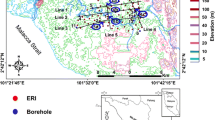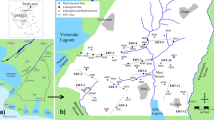Abstract
Guinea worm and other water borne diseases associated with untreated surface water use have necessitated that communities are supplied with groundwater in the Northern Region of Ghana. The Electrical Resistivity Survey (ERS) method is one of the common geophysical survey techniques used for borehole siting in Ghana. Various groundwater exploration programs have utilized it by employing the four electrode system. However, the ERS has not been able to locate potential borehole sites successfully in the Voltaian Sedimentary Basin (VSB) in the Northern Region of Ghana although it has been successful in other geological formations. Unsatisfactory results obtained from the employment of the ERS system in the VSB therefore necessitated an experiment with the 2-D Multi-Electrode Resistivity Imaging (2-D MERI) technique. Field results show that the 2-D MERI is a robust and efficient technique: an improvement on the four electrode ERS system in terms of amount and quality of data obtained. The 2-D MERI interpretations were confirmed with a much improved borehole drilling success rate of 60% compared to 38% obtained using the ERS within the mudstone and shale formations. The 2-D MERI also indicated that very low resistivity layers in the VSB may not necessarily be good targets for borehole drilling and the generally held notion that groundwater cannot be found at depths more than 25 m is no longer tenable.







Similar content being viewed by others
References
Acheampong, P. K., 1988, Water balance analysis for Ghana: Geography, v. 73, no. 2, p. 125–131.
Anon, 2000, Unpublished technical report, International Development Agency (IDA) funded 80 borehole drilling program, 150 pp.
Anon, 2001, Technical proposal for the rural water supply and sanitation in the Northern Region, Unpublished report for the Community Water and Sanitation Agency (CWSA), 84 pp.
Anon, 2002, Baseline study and inventory of water resources in the Northern Region of Ghana, AFD rural water supply and sanitation project in the Northern Region, 125 pp.
Anon, 2007, ABEM Instruction Manual for SAS 1000/4000 Terameter, ABEM Instrument ABS-17266 Sundbyberg, Sweden, 135 pp.
Dapaah-Siakwan, S., and Gyau-Boakye, P., 2000, Hydrogeologic framework and borehole yields in Ghana: Hydrogeol. J., v. 8, p. 405–416.
de Jong, A., 2004, GeoVES XL V1.3 software: Geosearch International Limited, Northern Ireland, UK.
Ewusi, A., 2006, Groundwater exploration and management using geophysics in the Northern Region of Ghana, Unpublished PhD thesis: Brandenburg Technical University, Chair of Environmental Geology, Germany, 171 pp.
Gyau-Boakye, P., and Dapaah-Siakwan, S., 1999, Groundwater: solution to Ghana’s rural water supply industry?: The Ghana Engineer, Accra, Ghana, p. 8.
Kesse, G. O., 1985, The mineral and rock resources of Ghana: A.A Balkema, Rotterdam, p. 610.
Kwei, C. A., 1997, Evaluation of groundwater potential in the Northern Region of Ghana: Canadian International Development Agency (CIDA) Accra, Ghana, p. 69.
Loke, M. H., 2004, Geoelectrical imaging 2-D & 3-D: Geotomo Software, Malaysia, p. 133.
Author information
Authors and Affiliations
Corresponding author
Rights and permissions
About this article
Cite this article
Ewusi, A., Kuma, J.S. & Voigt, H.J. Utility of the 2-D Multi-Electrode Resistivity Imaging Technique in Groundwater Exploration in the Voltaian Sedimentary Basin, Northern Ghana. Nat Resour Res 18, 267–275 (2009). https://doi.org/10.1007/s11053-009-9102-4
Received:
Accepted:
Published:
Issue Date:
DOI: https://doi.org/10.1007/s11053-009-9102-4




